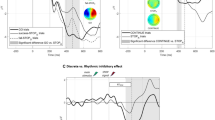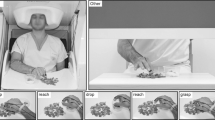Abstract
The ability to prepare movement is an essential requirement for the control of goal-directed actions. It allows us to respond in an adaptable and swift manner to environmental conditions. In the present study, we manipulate cognitive context, by means of response probability, to modify the degree of movement preparation in a delayed cueing task performed with the right hand, and evaluate the neural dynamics (EEG coherence) and behavioural output (reaction time). Task-related coherence was stronger over the contralateral hemisphere. In particular, coherence between the left sensorimotor area and frontal (C3-F3, C3-FC3) and parietal (C3-P3) regions was increased during right-hand movement preparation as compared to rest in the alpha frequency band (8–12 Hz). Reducing response probability diminished the degree of functional coupling between C3-F3 and C3-FC3, and was associated with a prolonged reaction time. These findings suggest an association between neural dynamics and behavioural performance and emphasize that response predictability biases information processing in goal-oriented behaviour.





Similar content being viewed by others
References
Andersen RA (1997) Multimodal integration for the representation of space in the posterior parietal cortex. Philos Trans R Soc Lon B Biol Sci 352:1421–1428
Başar E, Başar-Eroglu C, Karakas S, Schürmann M (1999) Are cognitive processes manifested in event-related gamma, alpha, theta and delta oscillations in the EEG? Neurosci Lett 259:165–168
Bressler L (1995) Large-scale cortical networks and cognition. Brain Res Rev 20:288–304
Cantero JL, Atienza M, Salas RM, Gomez CM (1999) Alpha EEG coherence in different brain states: an electrophysiological index of the arousal level in human subjects. Neurosci Lett 271:167–170
Casey BJ, Forman SD, Franzen P, Berkowitz A, Braver TS, Nystrom LE, Thomas KM, Noll DC (2001) Sensitivity of prefrontal cortex to changes in target probability: a functional MRI study. Hum Brain Mapp 13:26–33
Connolly JD, Goodale MA, Menon RS, Munoz DP (2002) Human fMRI evidence for the neural correlates of preparatory set. Nat Neurosci 5:1345–1352
Deiber MP, Ibaňez V, Sadato N, Hallett M (1996) Cerebral structures participating in motor preparation in humans: a positron emission tomography study. J Neurophysiol 75:233–247
Dinse HR, Kruger K, Akhavan AC, Spengler F, Schöner G, Schreiner CE (1997) Low-frequency oscillations of visual, auditory and somatosensory cortical neurons evoked by sensory stimulation. Int J Psychophysiol 26:205–227
Evarts EV, ShinodaY, Wise SP (1984) Neurophysiological approaches to higher brain functions. Wiley, New York
Florian G, Andrew C, Pfurtscheller G (1998) Do changes in coherence always reflect changes in functional coupling. Electroencephalogr Clin Neurophysiol 106:87–91
Fuster JM (1993) Frontal lobes. Curr Opin Neurobiol 3:160–165
Georgopoulos AP (2000) Neural aspects of cognitive motor control. Curr Opin Neurobiol 10:238–241
Gerloff C, Richard J, Hadley J, Schulman AE, Honda M, Hallett M (1998) Functional coupling and regional activation of human cortical motor areas during simple, internally paced and externally paced finger movements. Brain 121:1513–1531
Gevins AS, Morgan NH, Bressler SL, Cutillo BA, White RM, Illes J, Greer DS, Doyle JC, Zeitlin GM (1987) Human neuroelectric patterns predict performance accuracy. Science 235:580–585
González-Hernández JA, Pita-Alcorta C, Cedeňo I, Bosch-Bayard J, Galán-Garcia L, Scherbaum WA, Figueredo-Rodriguez P (2002) Wisconsin Card Sorting Test synchronizes the prefrontal, temporal and posterior association cortex in different frequency ranges and extensions. Hum Brain Mapp 17:37–47
Homan RW, Herman J, Purdy P (1987) Cerebral location of international 10–20 system electrode placement. Electroencephalogr Clin Neurophysiol 66:376–382
Hummel F, Gerloff C (2001) Better swing together. Soc Neurosci Abstr
Klimesch W (1996) Memory processes, brain oscillations and EEG synchronization. Int J Psychophysiol 24:61–100
Klimesch W (1999) EEG alpha and theta oscillations reflect cognitive and memory performance: a review and analysis. Brain Res Rev 29:169–195
Klimesch W, Doppelmayr M, Schimke H, Pachinger T (1996) Alpha frequency, reaction time, and the speed of processing information. J Clin Neurophysiol 13:511–518
Liang H, Bressler SL, Ding M, Truccolo WA, Nakamura R (2002) Synchronized activity in prefrontal cortex during anticipation of visuomotor processing. Neuroreport 13:2011–2015
Miller EK (2000) The prefrontal cortex and cognitive control. Nat Rev Neurosci 1:59–65
Nunez PL (2000) Toward a quantitative description of large-scale neocortical dynamic function and EEG. Behav Brain Sci 23:371–437
Ohara S, Mima T, Baba K, Ikeda A, Kunieda T, Matsumoto R, Yamamoto J, Matsuhashi M, Nagamine T, Hirasawa K, Hori T, Mihara T, Hashimoto N, Salenius S, Shibasaki H (2001) Increased synchronization of cortical oscillatory activities between human supplementary motor and primary sensorimotor areas during voluntary movements. J Neurosci 21:9377–9386
Oldfield RC (1971) The assessment and analysis of handedness. The Edinburgh inventory. Neuropsychologia 9:97–113
Passingham RE (1993) The frontal lobes and voluntary action. Oxford University Press, Oxford
Pfurtscheller G, Stančák A Jr, Neuper C (1996) Event-related synchronization (ERS) in the alpha band—an electrophysiological correlate of cortical idling: a review. Int J Psychophysiol 24:39–46
Posner MI, Petersen S (1990) The attention system of the human brain. Annu Rev Neurosci 13:25–42
Quintana J, Fuster JM (1999) From perception to action: temporal integrative functions of prefrontal and parietal neurons. Cereb Cortex 9:213–221
Ray WJ, Cole HW (1985) EEG alpha activity reflects attentional demands, and beta activity reflects emotional and cognitive processes. Science 228:750–752
Schluter ND, Rushworth MF, Mills KR, Passingham RE (1999) Signal-, set-, and movement-related activity in the human premotor cortex. Neuropsychologia 37:233–243
Serrien DJ, Cassidy MJ, Brown P (2003) The importance of the dominant hemisphere in the organization of bimanual movements. Hum Brain Mapp 18:296–305
Shibata T, Shimoyama I, Ito T, Abla D, Iwasa H, Koseki K, Yamanouchi N, Sato T, Nakajima Y (1998) The synchronization between brain areas under motor inhibition process in humans estimated by event-related EEG coherence. Neurosci Res 31:265–271
Siegel M, Körding KP, König P (2000) Integrating top-down and bottom-up sensory processing by somato-dendritic interactions. J Comput Neurosci 8:161–173
Singer W (1993) Synchronization of cortical activity and its putative role in information processing and learning. Ann Rev Neurosci 18:555–586
Singer W (1994) Coherence as an organizing principle of cortical functions. Int Rev Neurobiol 37:153–183
Singer W (1998) Consciousness and the structure of neuronal representations. Phil Trans R Soc Lond B 353:1829–1840
Steinmetz H, Furst G, Meyer B-U (1989) Craniocerebral topography within the international 10-20 system. Electroencephalogr Clin Neurophysiol 72:499–506
Thatcher RW (1995) Tomographic electroencephalography/magnetoencephalography. Dynamics of human neural network switching. J Neuroimaging 5:35–45
Thoenissen D, Zilles K, Toni I (2002) Differential involvement of parietal and precentral regions in movement preparation and motor intention. J Neurosci 22:9024–9034
Toni I, Schluter ND, Josephs O, Friston K, Passingham RE (1999) Signal-, set- and movement-related activity in the human brain: an event-related fMRI study. Cereb Cortex 9:35–49
Von Stein A, Chiang C, König P (2000) Top-down processing mediated by interareal synchronization. Proc Natl Acad Sci U S A 97:14748–14753
Wei J, Zhao L, Yan G, Duan R, Li D (1988) The temporal and spatial features of event-related EEG spectral changes in 4 mental conditions. Electroencephalogr Clin Neurophysiol 106:416–423
Acknowledgements
The research was supported by the Medical Research Council of Great Britain and GlaxoSmithKline. We wish to thank Kielan Yarrow for programming expertise.
Author information
Authors and Affiliations
Corresponding author
Rights and permissions
About this article
Cite this article
Serrien, D.J., Fisher, R.J. & Brown, P. Transient increases of synchronized neural activity during movement preparation: influence of cognitive constraints. Exp Brain Res 153, 27–34 (2003). https://doi.org/10.1007/s00221-003-1578-2
Received:
Accepted:
Published:
Issue Date:
DOI: https://doi.org/10.1007/s00221-003-1578-2




